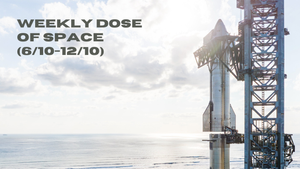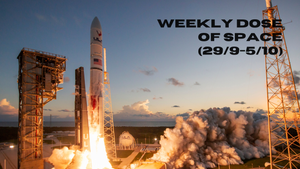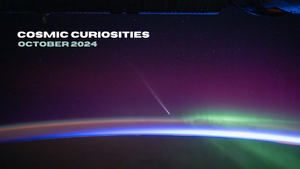
Weekly Dose of Space (6/10-12/10)
Welcome back to Weekly Dose of Space! This week had two orbital launches occur, one each from the major space powers. News this week had Falcon 9 cleared to return to flight, a new 40-meter radio telescope nearing completion, and a new signatory of the Artemis Accords. As always, we'll also look ahead to what the worldwide launch schedule might look like next week.
SpaceX
This week at Starbase began on October 7th when Ship 30 and Booster 12 conducted another partial tanking test on the orbital launch mount. A wet dress rehearsal ahead of the fifth flight test has not yet occurred, and at the time of writing likely won't.
In the early hours of October 8th after the tanking test, the launch pad deluge system conducted a separate test, flowing thousands of gallons of water underneath the orbital launch mount. In the sunlight hours of the 8th, Ship 30 was destacked from Booster 12 and placed near the launch tower.
October 9th had what is currently believed to be the installation of the flight termination system explosives on Booster 12 and Ship 30, these explosives will only be used in the event of major vehicle failure or risk to public safety. Testing of the launch towers 'chopsticks' also occurred late on the 9th.
On October 11th, Ship 30 was lifted back onto Booster 12 for the final stacking ahead of the fifth flight test. The following day, the U.S. Federal Aviation Administration granted SpaceX a launch license for the fifth flight test, removing the last major obstacle to launch.
Launches This Week
October 7th - Falcon 9 with Hera
A Falcon 9 launched the European Space Agency's Hera mission from Space Launch Complex 40, in Florida. Hera is heading to the Didymos binary asteroid system to study the effects of NASA's DART mission to improve understanding of planetary defense missions.
Supporting this mission was booster B1061, making its twenty-third and final flight.

October 10th - Long March 3B/E with WHG-03
The China Academy of Launch Vehicle Technology's Long March 3B/E lifted off from the Xichang Satellite Launch Center carrying the WHG-03, also known as internet high-orbit satellite, to a geostationary transfer orbit. This was also the 99th launch of a Long March 3B launch vehicle.

In Other Space News
40-meter-aperture radio telescope installed in Xizang

On October 7th the main reflector of the antenna system of the 40-meter-aperture radio telescope was lifted and installed in the Xizang Autonomous Region, located in western China.
The telescope was reportedly jointly developed by the Shanghai Astronomical Observatory, under the Chinese Academy of Sciences, and the 39th Research Institute of China Electronics Technology Group Corporation. Completion of the telescope in Xizang is currently expected by the end of 2024, with observation and system testing appending in early 2025.
The 40-meter-aperture radio telescope is part of China's very-long-baseline interferometry network. China's very-long-baseline interferometry network currently consists of four observatories, in Beijing, Shanghai, Urumqi, and Kunming, that together accurately track lunar and deep-space probes. Another 40-meter radio telescope is also under construction in Jilin province to further expand the network.
Dominican Republic joins the Artemis Accords
The Dominican Republic has become the 44th country to sign onto the U.S.-led Artemis Accords, on October 7th. Sonia Guzmán, ambassador of the Dominican Republic to the United States, signed the accords on behalf of the country. Guzmán said the following after the signing:
“This marks a historic step in our commitment to international collaboration in space exploration,” – “This is not just a scientific or technological milestone – it represents a future where the Dominican Republic contributes to the shared goals of peace, sustainability, and innovation beyond our planet. By joining the global effort to explore the Moon, Mars, and beyond, we are also expanding the opportunities particularly for our young Dominicans in science, education, and economic development.”
NASA Administrator Bill Nelson welcomed the nation to the accords after the singing. Nations that have signed the Artemis Accords so far are: Australia, Canada, Italy, Japan, Luxembourg, the United Arab Emirates, the United Kingdom, the United States, Ukraine, the Republic of Korea, New Zealand, Brazil, Poland, Mexico, Israel, Romania, Bahrain, Singapore, Colombia, France, Saudi Arabia, Nigeria, Rwanda, the Czech Republic, Spain, Ecuador, India, Argentina, Germany, Iceland, the Netherlands, Bulgaria, Angola, Belgium, Greece, Uruguay, Switzerland, Sweden, Slovenia, Lithuania, Peru, Slovakia, and Armenia.
Falcon 9 cleared to return to flight
On October 11th, the U.S. Federal Aviation Administration cleared SpaceX to return Falcon 9 to flight. Falcon 9 was grounded following an anomaly during second-stage disposal after the Crew-9 mission. The statement from the agency is as follows:
“The FAA notified SpaceX on Oct. 11 that the Falcon 9 vehicle is authorized to return to regular flight operations. The FAA reviewed and accepted the SpaceX-led investigation findings and corrective actions for the mishap that occurred with the Crew-9 mission (Sept. 28)."
"Also on Oct. 11, FAA closed the SpaceX-led investigations for the Falcon 9 mishaps that occurred with the Starlink 9-3 (July 11) and Starlink 8-6 (Aug. 28) missions.”
What to Expect Next Week
Starbase
SpaceX is expecting to launch Starship-Super Heavy on Sunday October 13th, or already has due to when this newsletter is published. The U.S. Federal Aviation Administration, on October 12th, also granted SpaceX a launch license for the fifth flight test. For this flight, Ship 30 is aiming to survive atmospheric reentry while Booster 12 is hoping to be caught back at the launch site.
Whatever happens for this flight test, excitement is absolutely guaranteed.
Due to when this newsletter is published, some of these missions may have already launched.
October 13th - Starship-Super Heavy for Flight 5
SpaceX is targeting October 13th to launch the fifth flight test of its Starship-Super Heavy vehicle. As already mentioned, for this flight Ship 30 is aiming to survive atmospheric reentry while Booster 12 is hoping to be caught back at the launch site.
October 14th - Falcon Heavy with Europa Clipper
Falcon Heavy is expected to fly a fully expendable mission carrying NASA's Europa Clipper mission from Launch Complex 39A. Europa Clipper will head to Jupiter's moon Europa to study it.
October 14th - Falcon 9 with Starlink Group 10-10
A Falcon 9 is expected to launch from Space Launch Complex 40 carrying a batch of Starlink satellites to low Earth orbit.
October 15th - Falcon 9 with Starlink Group 9-7
Another Falcon 9 is aiming to launch from Space Launch Complex 4E, in California, carrying another batch of Starlink satellites to low Earth orbit.
October 15th - Long March 6A with a to-be-announced payload
A Long March 6A is believed to be targeting a launch from the Taiyuan Satellite Launch Center. The payload onboard is unknown, rumors about this launch have it carrying the second batch of eighteen Qianfan satellites.
October 16th - Long March 4C with a to-be-announced payload
A Long March 4C is believed to be targeting a launch with an unknown payload from the Jiuquan Satellite Launch Center.
October 16th - Falcon 9 with Starlink Group 8-19
Falcon 9 is targeting a launch from Space Launch Complex 40 to low Earth orbit carrying another batch of Starlink satellites.




